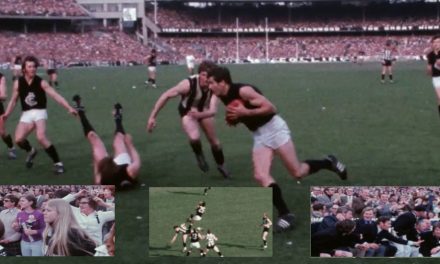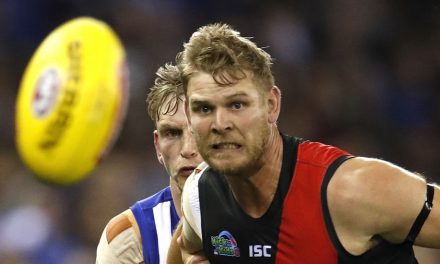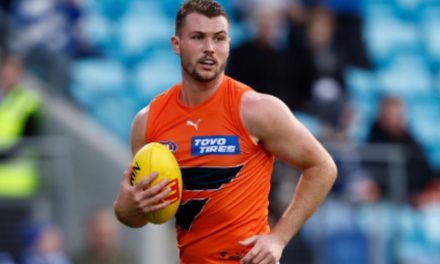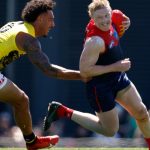Sydney young gun Chad Warner leaves the Tigers in his wake during the Swans’ win over Richmond. Photo: AFL MEDIA
This blistering start to the season by the Sydney Swans would have perhaps been best accompanied by one of those viewer discretion warnings.
As frighteningly potent as the Swans have so far looked, brushing aside the Tigers within their impenetrable fortress, doing similar to the Lions at the Gabba and breezing by Adelaide in between, their re-emergence as a competition force is having an equally harmful triggering effect upon some footy fans.
After a brief, two-season departure from central stage, the Swans have torn back the curtain and plunged their way back into the AFL zeitgeist.
To help navigate the recasting of one of the league’s apparently most vile villains, we’ve developed a survival guide (of sorts) for those uncomfortable with their current programming.
Make peace with Sydney’s concessions (seriously)
If you’re the kind of person who’s noticed Sydney’s pulsating 3-0 start and who’s only recourse is to point out the Swans’ understandably diabolical academy program, then this might be the most helpful part of our guide.
Yes, though it’s important to acknowledge that any system that enables a club to harvest an academy that drops elite talent like Isaac Heeney through to Braeden Campbell on their doorstep as obscene and a blight upon equalisation, it’s equally important to appreciate it as merely a cog in overly and unashamedly crooked mechanism.
In the modern AFL, there’s nothing by way of an equitable fixture, which, speaking of, is notorious for shoe-horning larger, though struggling clubs such as Carlton and Essendon into marquee time-slots.
This is a competition where home ground advantage is effectively null and void for 10 of Victoria’s clubs with the exception of Geelong. Speaking of the Cats, they, like the Western Bulldogs, have benefited massively from the cute though kind of bonkers father-son rule.
Still on rules and regulations, the AFL’s current free agency structure isn’t exactly a beacon of fairness, with players such as Tom Lynch and Jeremy Cameron gravitating to clubs in the premiership window, effectively promoting a league where strong clubs are allowed to stay strong, while weaker outfits are left to scrounge around in the gutter to find their ticket to list management riches.
PLEASE HELP US CONTINUE TO THRIVE BY BECOMING AN OFFICIAL FOOTYOLOGY PATRON. JUST CLICK THIS LINK.
Finally, and may well he win a handful of premierships, but there’s 17 clubs in the competition who will forever be repulsed by the manner in which Jamarra Ugle-Hagan found his way to the Whitten Oval last December.
Truly, the AFL is anything but a level playing field, with every recent premier saddled with a series of asterisks, and while your highlighting of Sydney’s leg-up is legitimate, let’s not pretend it’s the only club who routinely dips its hands in the till.
Don’t stress, because they probably won’t win the premiership anyway
Yes, the Swans have been profoundly good through their initial trio of games, with the number crunchers at Stats Insider elevating them to fourth favourites for the flag. That said, we should note they’re still an 89.5 per cent chance of not winning the premiership this season, which is a highly favourable number for those repulsed by the notion of them doing so.
While Sydney’s start has been scary good, showcasing the kind of prestigious young talent which has the Swans housing the AFL’s four favourites for the Rising Star, (and likely auguring yet another era of harbourside success), there’s equally very little precedent to what we’re seeing, and which might indeed be enough to forestall a 2021 Sydney flag.
While it’s been well-documented that Sydney had missed multiple finals series for the first time since 1995, it’s well worth considering that it’s almost unheard of for a team to miss back-to-back finals and win a flag the following season.
Through VFL-AFL history we’ve had just 7 examples of a club doing so, the most recent case being Adelaide in 1997, while we’d then have to go back to the 1980 Tigers, who also did the same in 1967.
Hawthorn’s first two premierships in 1961 and 1971 were accomplished under these circumstances, as was Geelong’s third flag in 1937. Melbourne, in the year 1900, was the competition’s first.
For fans jolted by the sudden impact of a revitalized Swans, consider the above numbers a key feature of this survival guide.
And finally, try to enjoy what Sydney are doing
No, you mightn’t be comfortable with Sydney’s short and long-term prospects, but what’s undeniable is that the Swans are playing some seriously divine football.
When the Swans contested no less than five grand finals between 2005 and 2016, they were famous for their ruthless edge, appetite for the contest, and proclivity for the more physical, down-and-dirty components of our sport.
These Swans, however, are playing some of the league’s most progressive and attractive football, punctuated by leading the competition for points scored, all underpinned by a decidedly no-nonsense game plan.
Their lofty 1.75 kick-to-handball ratio ranks fourth in the league, and is contributing to an elaborate game of “keepings off”, whereby the Swans are enjoying a ridiculous 38.7 mark differential. The knock-on effect is that Sydney is also leading the league in both inside 50s and marks inside 50, generating 60.7 and 17.7 respectively per game.
While you’re entitled to question what any of Sydney’s on-field transformation means for less fortunate clubs, these Swans are perhaps operating as an example struggling clubs should look toward with regards implementing a workable game plan that’s commensurate with the talent at their disposal.
While John Longmire and his coaching team had obviously drained every last drop out of the Swans previous “blue collar” incarnation, they should be highly commended for developing something entirely different and which is not only perfect for the changing face of the game, but which may well have Swans detractors on their therapist’s couch for years to come.
You can read more of James Rosewarne’s work at STATS INSIDER











